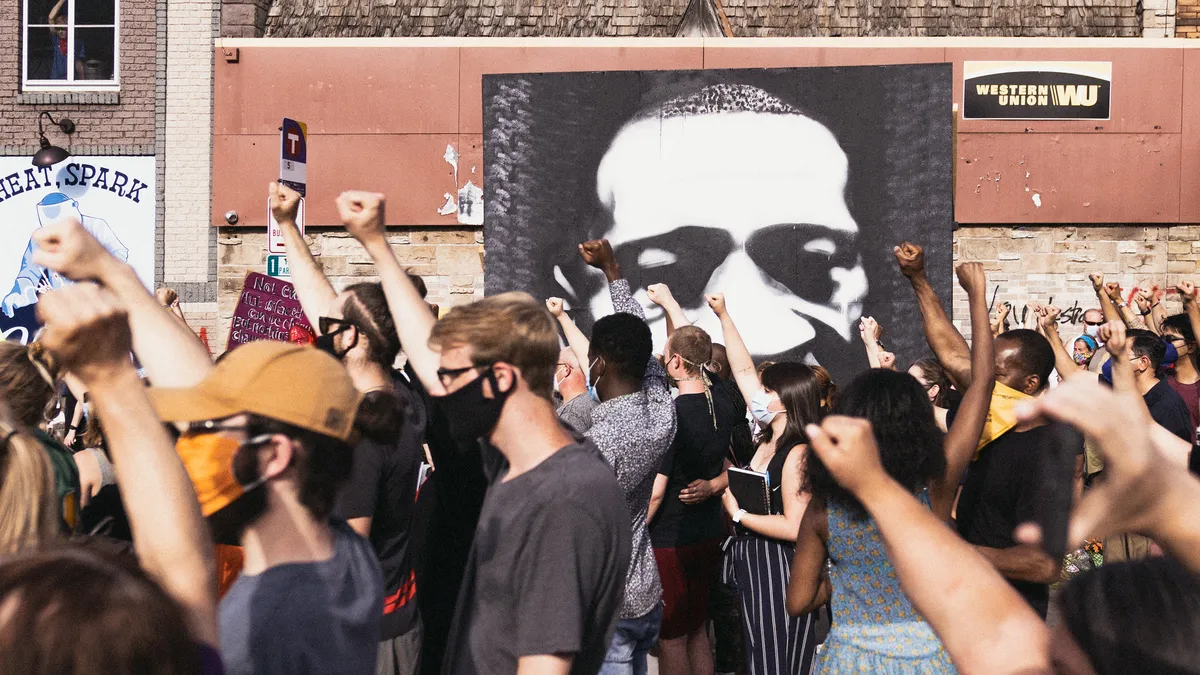Dive Brief:
- The Department of Homeland Security's (DHS) Customs and Border Patrol (CBP) deployed surveillance vehicles over Black Lives Matter (BLM) demonstrations in 15 major cities earlier this month, collecting 270 hours worth of footage, according to a report in the New York Times. CBP confirmed the Times' reporting and additional details to Smart Cities Dive.
- CBP Air and Marine Operations (AMO) flew surveillance helicopters, airplanes and drones over the following cities at various times from May 29 through June 16. Predator drones, unmanned aircrafts used by the federal government, were only deployed in Minneapolis and Del Rio, TX, according to CBP.
| City | Hours of footage |
|---|---|
| Aurora, IL | 12.1 |
| Buffalo, NY | 38.3 |
| Chicago | 14.6 |
| Dayton, OH | 1.3 |
| Del Rio, TX | 4.8 |
| Detroit | 77.8 |
| El Centro, CA | 5.1 |
| El Paso, TX | 13.6 |
| Miami | 24.5 |
| Minneapolis | 5.5 |
| New York | 10.4 |
| Philadelphia | 9.1 |
| San Luis, AZ | 1.5 |
| Uvalde, TX | 2.9 |
| Washington, DC | 48.3 |
- CBP confirmed AMO "does not possess or utilize facial recognition technology on any of its aircraft," and that on-board cameras of AMO vehicles "cannot provide enough resolution or detail to identify a person ... or to discern a vehicle license plate number." CBP did not respond to requests for specific details on how the collected footage will be used.
Dive Insight:
The police killing of George Floyd in Minneapolis on May 25 started a national uprising of demands for racial equality and police reform.
In a statement shared with Smart Cities Dive, CBP Acting Commissioner Mark Morgan said the department "stands united in holding those accountable for the death of Mr. George Floyd," but that it is equally committed to holding criminals responsible for looting businesses and engaging in violent behavior amid protests.
Chicago was one city that witnessed dramatic destruction of property, yet some business owners saw past physical damage to acknowledge the core messages of the demonstrations. In an opinion piece for NBC News, Chicago food store owner Asalh Ghasim said the looting of her store has put her family "into debt," but she pointed the blame at "the people who racially target minorities."
Nusrat Choudhury, legal director for the ACLU of Illinois, told Smart Cities Dive that DHS's use of surveillance on people who are protesting lack of racial justice by law enforcement, in Chicago and nationally, is "ironic and deeply disturbing."
"We know that when there’s surveillance of protesters, it can be used to try to harass and discredit and disrupt that activity through prosecution of low-level offenses, through more troubling and aggressive attempts to harm people," Choudhury said. "This is not a unique phenomenon to the current moment. It’s an iteration of a long and sordid history of the government spying on people who actively protest racial injustice."
When asked for a reaction to the CBP's statement of unity with BLM advocates, Devren Washington, senior policy organizer of the Philadelphia-based Movement Alliance Project, told Smart Cities Dive "it really makes me sick." He also pointed to the irony of surveilling looters or violent activists at a time when those activists are condemning violence themselves.
"The rhetoric that they want to surveil activists that are calling to defund the police and saying to put those funds into community services that would keep us safe, is for me ironic," Washington said. "The real problem here — what really needs to be reigned in — is the greed that is siphoning resources out of the communities, which lays the ground for the unrest that we’re seeing at this moment."
Choudhury said if DHS truly stands with the message of BLM advocates, it should do more to show that the footage collected will not be used against demonstrators. In the meantime, Choudhury encouraged residents to "demand information about the surveillance that's being carried out ... often with their own taxpayer dollars."
She also encouraged local governments to be more transparent in their own tech procurements, particularly with devices that contain surveillance capabilities, to better educate and inform residents of the tech that may be watching them as they demonstrate.














